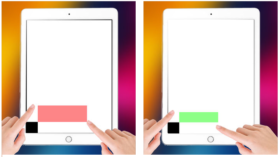Proportions
The extended version of the embodied design for proportions is implemented as a touch-screen application (Figure 1), where students can learn interactively how to solve a simple proportion problem such as 2:4 = 4:? (Figure 1). See the Instruction.
We have conducted eye-tracking studies with over a 100 students in primary and vocational schools (age 9-12), and recorded the hand movement, gaze behavior and thinking aloud conversation of the students.
We study how the app can stimulate and support proportional learning. For example, how does the addition of geometrical shapes and lines (slopes) alter the way students act, perceive and reason? (Figure 2). The long-term goal of this project is to explore how mathematics education can benefit from embodied cognition research so that students can ultimately develop a better grip on mathematics.
 Figure 2. Different conditions of the app with the same proportional problem.
Figure 2. Different conditions of the app with the same proportional problem.
Key References:
Abrahamson, D., Shayan, S., Bakker, A., & Van der Schaaf, M. (2016). Eye-tracking Piaget: Capturing the emergence of attentional anchors in the coordination of proportional motor action. Human Development, 58(4-5), 218–224. doi:10.1159/000443153
Duijzer, C. A. C. G., Shayan, S., Bakker, A., Van der Schaaf, M. F., & Abrahamson, D. (2017). Touchscreen tablets: Coordinating action and perception for mathematical cognition. Frontiers in Psychology, 8, 1–19. doi:10.3389/fpsyg.2017.00144
Shayan, S., Abrahamson, D., Bakker, A., Duijzer, A. C. G., & Van der Schaaf, M. F. (2017). Eye-tracking the emergence of attentional anchors in a mathematics learning tablet activity. In C. A. Was, F. J. Sansosti, & B. J. Morris (Eds.), Eye-tracking technology applications in educational research (pp. 166-194). Hershey, PA: IGI Global.
Master Thesis from previous students in the project:
Duijzer, Carolien. (2015). How Perception Guides Cognition: Insights from Embodied Interaction with a Tablet Application for Proportions – An Eye-Tracking Study. (Unpublished Master Thesis). Utrecht University.
Cuiper, Anne-Ciska. (2015). Vocational students’ search patterns while solving a digital proportion task of the Mathematical Imagery Trainer For Proportions application. (Unpublished Master Thesis). Utrecht University.
Veugen, Marijke. (2016). Defining Mathematical Proportional Embodied Learning Within Eye Tracking Measurements. (Unpublished Master Thesis). Utrecht University.
Boven, Loes. (2017). Coordination of Action and Perception Processes in an Orthogonal Proportion Tablet Task. (Unpublished Master Thesis). Utrecht University.

